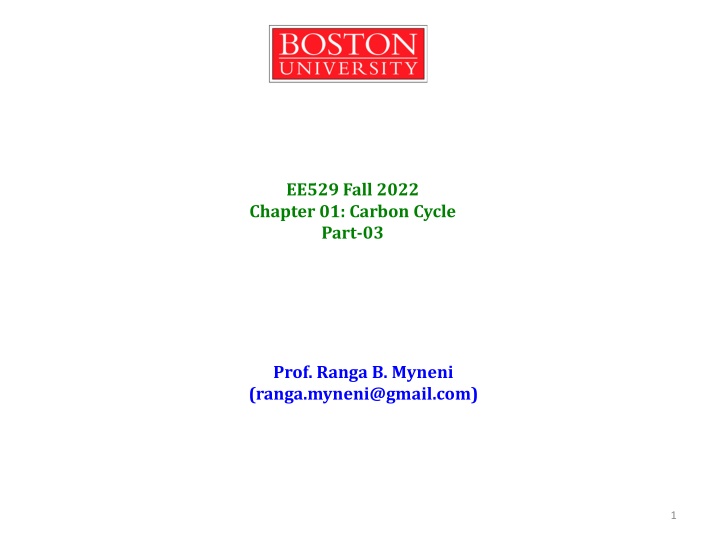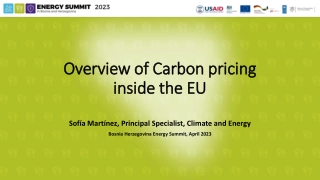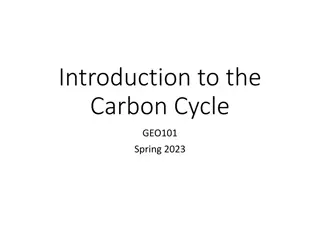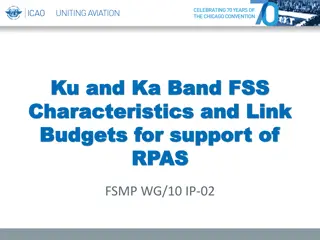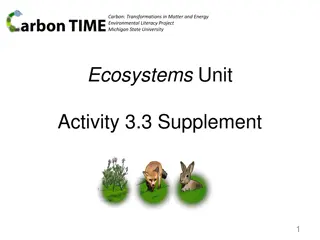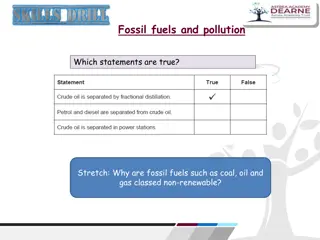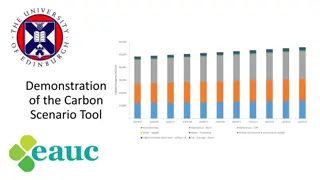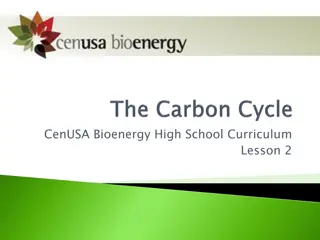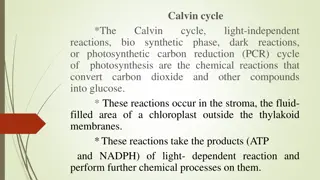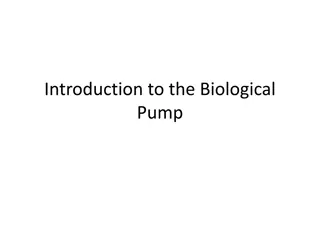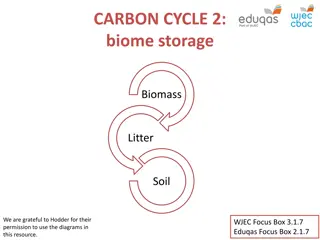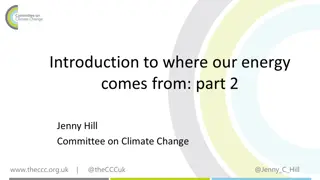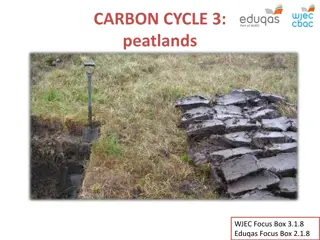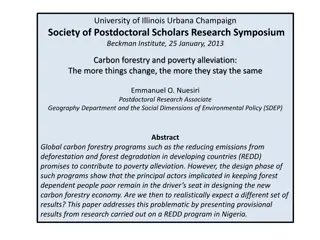Global Carbon Cycle and Carbon Budgets Overview
This material provides an in-depth overview of the global carbon cycle based on the IPCC 2013 report. It discusses carbon budgets, spatial and temporal patterns, and includes visuals illustrating concepts such as carbon fluxes, emissions, and sinks. The content delves into pre-industrial carbon cycles, current emissions, and the role of oceans and land in carbon storage. Additionally, it highlights the importance of understanding carbon exchange by terrestrial ecosystems.
Download Presentation

Please find below an Image/Link to download the presentation.
The content on the website is provided AS IS for your information and personal use only. It may not be sold, licensed, or shared on other websites without obtaining consent from the author.If you encounter any issues during the download, it is possible that the publisher has removed the file from their server.
You are allowed to download the files provided on this website for personal or commercial use, subject to the condition that they are used lawfully. All files are the property of their respective owners.
The content on the website is provided AS IS for your information and personal use only. It may not be sold, licensed, or shared on other websites without obtaining consent from the author.
E N D
Presentation Transcript
EE529 Fall 2022 Chapter 01: Carbon Cycle Part-03 Prof. Ranga B. Myneni (ranga.myneni@gmail.com) 1
Outline 1. Global Carbon Cycle (IPCC, 2013) 2. Carbon Budgets 3. Spatial and Temporal Patterns 4. References 2
1. Global Carbon Cycle (IPCC, 2013) Black Pool size Annual fluxes Pre-industrial Red Annual fluxes 2000 2009 period Total anthropogenic C Units Pg C 1750 = Pre-industrial Other +ve #s = C accumulation Uncertainties: 90% CI ? 3 (Credit: Ciais et al., 2013)
1. Global Carbon Cycle (IPCC, 2013) ? (Credit: Ciais et al., 2013) 4
1. Global Carbon Cycle (IPCC, 2013) Pre-industrial C Cycle Net Ocean Flux +0.7 Freshwater outgassing +1.0 Volcanism +0.1 Total = +1.8 Net land flux = -1.7 Rock weathering = -0.3 Total = -2.0 Ocean was a small source Land was a small sink Atm CO2 conc stable ? 5 (Credit: Ciais et al., 2013)
1. Global Carbon Cycle (IPCC, 2013) Current C Cycle Emissions = +(7.8 + 1.1) Total = 8.9 Ocean -2.3 Land -2.6 Atmosphere = -4 Total = -8.9 C removal from fossil fuels C removal from veg+soils C storage in Atm, Oceans & land Ocean is a sink Land is a sink ? 6 (Credit: Ciais et al., 2013)
2. Carbon Budgets Carbon budget for the 1980s and 1990s. Negative values denote flux from the atmosphere, that is ocean or land uptake. Credit: Schimel et al., (2001), Recent patterns and mechanisms of carbon exchange by terrestrial ecosystems, Nature, 414:169-172. 7
2. Carbon Budgets During the 1980s: Carbon emissions 5.4 +/- 0.3 Gt C/yr from fossil-fuel burning and cement manufacture 1.7 (0.6 to 2.5) Gt C/yr from land-use changes Total Emissions: 7.1 Gt C/yr Atmospheric carbon increase 3.3 +/- 0.1 Gt C/yr Net carbon flux into the oceans 1.9 +/- 0.5 Gt C/yr Net carbon flux into the land 0.2 +/- 0.7 Gt C/yr Total Accounted: 5.4 Gt C/yr 5.4 + 1.7 = 3.3 + 1.9 + 0.2 = 1.7 That is, there is still a 1.7 Gt C/yr missing sink per year For the 1990s, the estimates are somewhat similar, except a larger land carbon sink Many studies suggest 1 to 2 Gt C/yr sequestered on land in temperate and boreal regions 8
2. Carbon Budgets Detailed View of the Carbon Budget: Prior to the Industrial Era, that began in 1750, CO2 concentration fluctuated between 180 ppm and 290 ppm for at least 2.1 million years Between 1750 and 2011, combustion of fossil fuels and cement production released 375 30 Pg C to the atmosphere, and an additional 180 80 Pg C due to land use change, mainly deforestation For a total of 555 Pg C This carbon is called anthropogenic carbon 9
2. Carbon Budgets 555 85 Pg C of anthropogenic carbon emitted to the atmosphere less than half is accumulated in the atmosphere (240 10 PgC) The ocean stored 155 30 PgC of anthropogenic carbon since 1750 This ocean sink will continue to remove atmospheric CO2 until the entire ocean has re-equilibrated with the higher atmospheric CO2 Terrestrial ecosystems (not affected by land use change) have thus accumulated 160 90 PgC Table 3. Global anthropogenic CO2 budget, accumulated since the Industrial Revolution (onset in 1750) and averaged over the 1980s, 1990s, 2000s, and the last ten years until 2011. Note that, by convention, a negative ocean or land to atmosphere CO2 flux is equivalent to a gain of carbon by the ocean or land reservoirs. Credit: Ciais et al., 2013 (Credit: Ciais et al., 2013) 10
2. Carbon Budgets Land use flux is 180 80 Pg C Terrestrial ecosystems (not affected by land use change) have accumulated 160 90 PgC Land is not compensating the CO2 losses (net loss of about 20 Pg C) This storage in terrestrial ecosystems (Land sink) is thought to be due to enhanced photosynthesis at higher CO2 levels (CO2 Fertilization) N deposition changes in climate favoring carbon sinks (eg. longer growing seasons in mid-to-high latitudes) the expansion and increased biomass density of forests in temperate and boreal regions (Land use changes) Table 3. Global anthropogenic CO2 budget, accumulated since the Industrial Revolution (onset in 1750) and averaged over the 1980s, 1990s, 2000s, and the last ten years until 2011. Note that, by convention, a negative ocean or land to atmosphere CO2 flux is equivalent to a gain of carbon by the ocean or land reservoirs. Credit: Ciais et al., 2013 11 (Credit: Ciais et al., 2013)
3. Spatial and Temporal Patterns Results are for the 1980s (plain bars) and for 1990-1996 (hatched bars) Positive numbers are fluxes to the atmosphere Figure below shows: about 1 to 2 Gt C are sequestered in sinks on land north of 30N Elsewhere, the land is neutral, where sources nearly match sinks Precise geographic distribution of the northerly land sink remains unknown Zonal distribution of terrestrial and oceanic carbon fluxes. Credit: Heimann, M. (2001), Max-Planck Institute fuer Biogeochemi, Technical Report 2. 12
3. Spatial and Temporal Patterns There is considerable inter-annual variability in the CO2 flux to the atmosphere. Gray shaded regions indicate El Ni o episodes Black bars indicate the cooling period following the Mt. Pinatubo eruption, A positive flux means a larger than normal source of CO2 to the atmosphere (smaller sink) Tropical Land dominates inter-annual signal in CO2 flux to the atmosphere This, in turn, is determined by tropical temperature variations Land Ocean Credit: Ciais et al., 2013 13
3. Spatial and Temporal Patterns 14 Credit: Wang et al., 2013
4. References Recommended Readings: 1) Ciais et al., 2013. Carbon and Other Biogeochemical Cycles, IPCC AR5 Chapter 6, 2013. 15
